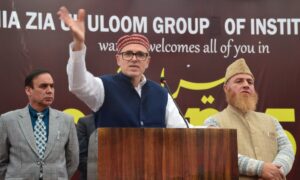![Part of a degraded forest in north Kashmir’s Bandipora district [image by: Athar Parvaiz]](https://impactnews.in/wp-content/uploads/2019/12/kash-forest-1-e1576304932258.jpg)
Part of a degraded forest in north Kashmir’s Bandipora district [image by: Athar Parvaiz]
Over 60% of the forest land diversions approvals are to build roads, and 33% (243 hectares) for the use of the army and paramilitary forces in Pir Panjal (Gulmarg Wildlife Sanctuary), Kehmil, Jhelum Valley, Samba and Jammu Forest divisions, analysis of the official documents revealed.
As many as 198 projects (most for road construction) have been approved by the FAC in four meetings on September 18, October 3, October 17, and October 21. In comparison to these 33 days of hectic activity, in all of 2018 97 projects involving diversion of forest land were cleared, 101 less than those cleared in four meetings.
Officials in Jammu & Kashmir’s Forest Department said that all these decisions had to be taken within a few weeks because of the implementation of Jammu & Kashmir Reorganisation Act from October 31, 2019. This Act leads to the scrapping of the Jammu & Kashmir Forest Act (under which the FAC was formed) of the former state after the implementation of Reorganisation Act.
Article 370 of the Indian Constitution, in existence for the past seven decades, guaranteed special status to the Himalayan state of Jammu and Kashmir whereby it was empowered to make its own laws. That article was abolished by the Indian Parliament last summer.
Speaking on the condition of anonymity, a member of the former FAC said that many of the projects now approved were in the waiting list for years. They had not been cleared because there were questions from the FAC. Those questions had still not been answered. But the clearances were given “in a hasty manner.”
Kashmir’s environment in jeopardy
When Kashmiris talk about the significance of forests, they refer to one of the most popular sayings of 15th century saint and poet Sheikh ul Alam: “Ann poshi teli yeli wan poshi (food will last as long as forests last).” Kashmir’s evergreen coniferous forests and snow covered peaks have a direct bearing on the region’s agriculture, energy and tourism sectors. Its beautiful lakes, rivers, agricultural plains and meadows owe their existence and economic production to the forests.
![Kashmir’s forests are known for their conifer varieties [image by: Athar Parvaiz]](https://impactnews.in/wp-content/uploads/2019/12/Kashmirs-forests-are-known-for-conifer-varieties-Photo-Athar-Parvaiz-e1576305120956.jpg)
Kashmir’s forests are known for their conifer varieties [image by: Athar Parvaiz]
The effects of degradation of forests is already visible in drying up of perennial water sources at many places, accelerated soil erosion, flash floods, silting up of reservoirs, loss of biodiversity and reduced forest productivity. The armed conflict has made things even more difficult. Official records at J&K’s forest department reveal that as many as 79 forest officials including one conservator have lost their lives while trying to protect forests. Forest department officials say they have been attacked by both militants and security forces.
Quoting statistics from one of his recent studies, Mohammad Sultan Bhat, who heads Kashmir University’s Geography department, said that area under dense forests around the tourist resort of Pahalgam in southern Kashmir fell by 191 square kilometres from 1961 to 2010 with an average annual loss of 3.9 square kilometres, largely due to illegal construction in designated forest areas.
Sparser forest areas, Bhat said, did not fare so badly over the study period, until recently. “From 2001 to 2010, even they decreased in size by nearly 10% a year,” Bhat said, adding, “this could be attributed to the fact that the dense forests were initially changed into sparse forests and in the later stage these sparse patches were utilised for agriculture and residential purposes.”
Are Kashmir’s forests recovering?
As per the Forest Survey of India’s (FSI) 2017 Report, forest cover in J&K increased with a net gain of 253 square kilometres in comparison to the forest cover in 2015.
But Akhlaq Wani, an Assistant Professor at the Division of Natural Resource Management, Faculty of Forestry in Srinagar’s Sher-i-Kashmir University of Agricultural Sciences and Technology (SKUAST) says that out of 253 square km increase in forest area, 245 square km is in the part of Kashmir under control of Pakistan since 1948. India has always claimed the entire area.
Further, many of the districts that saw growth in forests, according to the 2017 FSI report 2017, actually saw growth in horticulture rather than forests, experts say. This includes Budgam (61 square km), Baramullah (34 square km) and Pulwama (21 square km) districts. “If we analyse the historic forest cover of these districts, [they] witnessed deforestation as well as degradation in the past decades [as per published research]. But, at the same time, these regions have witnessed a steep increase in area under horticulture. Wani said if there is horticulture in an area above one hectare, it qualifies as forest cover as defined by FSI.
Under such circumstances, he said, it becomes difficult to check how much of the increased forest cover can be attributed to slow growing coniferous forests. And now even those face the axe.
By Athar Parvaiz
[the_ad id=’22722′]
This article was originally published in The Third Pole. To read the original article click here :
https://www.thethirdpole.net/en/2019/12/12/kashmirs-forests-face-the-axe/


















